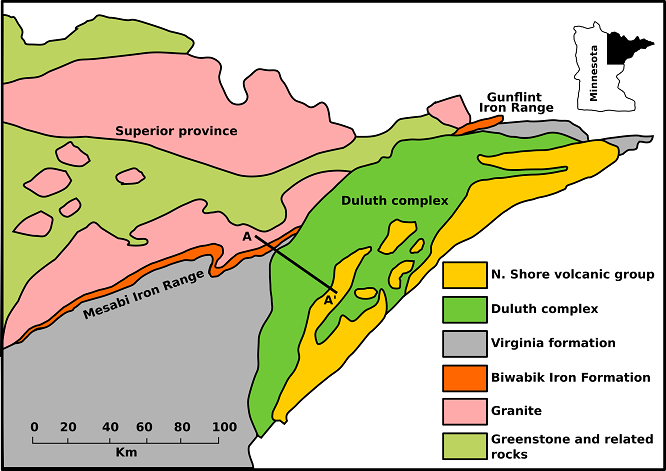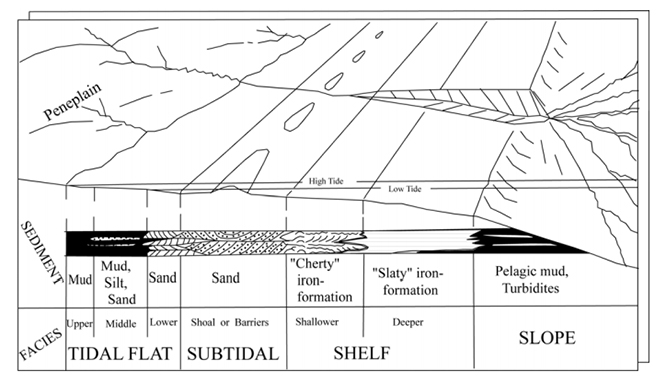Minnesotaite - (Fe,Mg)3Si4O10(OH)2
Minnesotaite was named in 1944 by John W. Gruner, after whom the mineral grunerite is named, in the banded iron formations of northern Minnesota. Gruner found the mineral in some abundance in parts of the iron formation of the Mesabi Iron Range exposed at Biwabik. It occurs associated with quartz, siderite, stilpnomelane, greenalite and magnetite. In addition to the low grade metamorphic banded iron formations it has also been reported as an alteration mineral associated with sulfide bearing veins. As shown by Gruner (L944), minnesotaite, with chemical formula (Fe,Mg)3Si4O10(OH)2, has a structure similar to that of talc Mg3Si4O10(OH)2. Chemical analyses of minnesotaite show that the only major substitution occurs between Mg and Fe, with almost all of the iron present as Fe2+.Biwabik Iron Fromation
The Biwabik Formation extends for 190 km across northern Minnesota (Fig.1). It is separated from the correlative, 1.9 Ga Gunflint Formation of Ontario by the intrusion of the 1.1 Ga Duluth gabbro, which developed a spectacular contact aureole within these iron formations. The Biwabik Iron Formation occurs as a thick (100-250 m), laterally extensive sheet that is slightly tilted to the south-southeast. It conformably overlies the Pokegama Quartzite, siltstone, and conglomerate unit of variable thickness (0-100 meters), and is overlain by the Virginia Formation, a thick, but poorly exposed sequence of shale and graywacke (Fig.2). Collectively, this stratigraphic sequence (Pokegam-Quartzite-Biwabik Iron Formation-Virginia Formation) is called the Animikie Group. A U-Pb zircon date from a tuffaceous unit in the nearby Gunflint Iron Formation yielded an age of 1,878.3 ± 1.3 million years (Fralick et al., 2002).
Fig.1: Simplified geologic map of the Mesabi Iron Range and adjacent Duluth Complex. Modified from Jirsa, M. A., Miller Jr, J. D., & Morey, G. B. (2008).

Fig.2: Schematic geologic section showing the basal contact of the Duluth Complex against older host rocks including the Biwabik Iron Formation, and capped by volcanic rocks of the North Shore Volcanic Group. Modified from Jirsa, M. A., Miller Jr, J. D., & Morey, G. B. (2008).
The Animikie Group rests unconformably on granite, greenstone, and other rocks of the Archean (greater than 2.4 billion years old) Superior Province, which constitutes the bedrock in most of northern Minnesota. At the northeast terminus of the Mesabi Iron Range near Babbitt, the Biwabik Iron Formation and other units of the Animikie Group are abruptly truncated by gabbroic rocks of the Duluth Complex. The lowest-grade rocks in the Biwabik Formation are composed of fine-grained quartz, magnetite, siderite, greenalite, and locally, hematite and minnesotaite. Layering occurs on the scale of millimeter to a few centimeter.
Since the early 20th century, the Biwabik Iron Formation has been subdivided into four informal members referred to as (from bottom to top): Lower Cherty member, Lower Slaty member, Upper Cherty member, and Upper Slaty member (Wolff, 1917). The cherty members are typically characterized by a granular (sand-sized) texture and thick-bedding (beds several inches thick); whereas, the slaty members are typically fine-grained (mud-sized) and thin-bedded (1 cm thick beds). The Biwabik Iron Formation is interpreted to have been deposited seaward on a shallow marine, tidally dominated shelf (Fig.3). Precipitation of iron minerals including iron carbonate, iron silicate, chert, and perhaps some hematite, occurred on the outer shelf in waters below wave base, giving rise to the mud-textured (slaty) iron-formation. These minerals were likely related to upwelling waters from the deeper part of the basin. The two sand-textured members (Lower Cherty and Upper Cherty) formed in a shallow-water, high energy environment, as indicated by stromatolites, cross-bedding, and rounded (locally oolitic) grains of iron minerals and chert.

Fig.3: Sedimentation model of Biwabik Iron Formation.
.jpg)
Biwabik Iron-Formation, Rouchleau Pit, Minnesota, USA. From James St. John.
.jpg)
Brown minnesotaite crystals, Black Hills, South Dakota, USA. From Geodil.
Sample kindly given to me by William Cordua - University of Wisconsin.
Bibliography
• Frost, C. D., von Blanckenburg, F., Schoenberg, R., Frost, B. R., & Swapp, S. M. (2007). Preservation of Fe isotope heterogeneities during diagenesis and metamorphism of banded iron formation. Contributions to Mineralogy and Petrology, 153(2), 211.
• Jirsa, M. A., Miller Jr, J. D., & Morey, G. B. (2008). Geology of the Biwabik iron formation and Duluth complex. Regulatory Toxicology and Pharmacology, 52(1), S5-S10.
• Gruner, J.W: The composition and structure of Minnesotaite: A common Iron silicate in Iron Formations
• Gruner, J.W., 1924, Contributions to the geology of the Mesabi range: With special reference to the magnetites of the iron-bearing formation west of Mesaba: Minnesota Geological Survey Bulletin 19.
• Mark J. Severson: Geology and Stratigraphy of the centra Mesabi Range. Field Trip


.jpg)
.jpg)
.jpg)
.jpg)
.jpg)
.jpg)
.jpg)
.jpg)
.jpg)
.jpg)
.jpg)
.jpg)
.jpg)
.jpg)
.jpg)
.jpg)
.jpg)
.jpg)
.jpg)
.jpg)
.jpg)
.jpg)
.jpg)
.jpg)
.jpg)
.jpg)
.jpg)
.jpg)
.jpg)
.jpg)
.jpg)
.jpg)
.jpg)
.jpg)
.jpg)
.jpg)